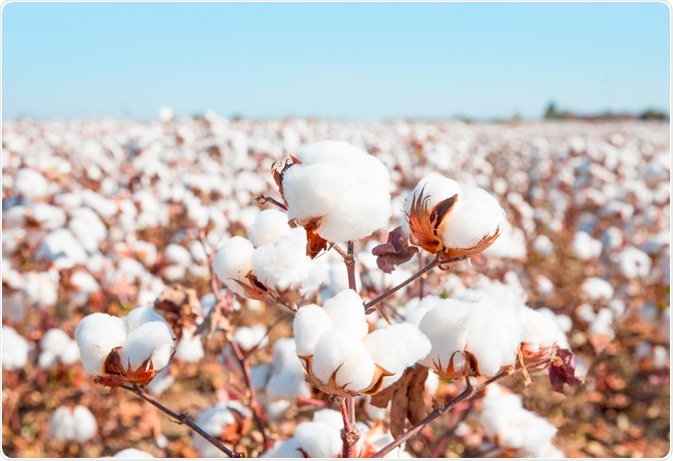Water stress can detrimentally impact the growth and productivity of the cotton plant.
Drought, the absence of sufficient and regular water supply, can impact physiological traits of the plant such as photosynthesis, leaf area, leaf-relative water content, excised leaf water loss, and leaf water potential, as well as the quantitative traits of the plant, such as plant height, crop yield, fiber quality, seedling-related traits, vegetative stage, reproductive stage, and gas exchange parameters.

Image Credit: muratart/Shutterstock.com
Studying and understanding how water stress impacts the cotton plant in all of these ways is essential for allowing plant scientists to establish cotton plants that are resistant to drought, to prevent damage to the quality and quantity of crop yields.
Physiological traits impacted by water stress
Photosynthesis
Drought has the impact of reducing the rate of photosynthesis. Studies have shown that a reduction in available water has the impact of reducing the photosynthetic rate. It also reduces carbon dioxide uptake and transpiration rates.
This has been shown to lead to a reduced rate of poll production, and, therefore, a reduced crop yield. Research has determined that the closure of stomata (the pores that facilitate gas exchange in plants) that occurs in drought conditions is responsible for the reduction in leaf photosynthesis.
Leaf area
Under drought conditions, the leaf area of the cotton plant reduces. Scientists have determined that plants that are more tolerant to drought conditions have smaller leaves. This feature is of special interest to scientists wanting to breed drought resistant plants.
Leaf-relative water content
The cotton plant has been observed as reducing its relative water content (RWC) in times of insufficient water supply and drought. RWC has long been used as a robust indicator of water status in plants, in drought, it can indicate the cellular water deficit that results as a physiological consequence of not receiving enough water.
Studies have shown that RWC is higher in drought-resistance genotypes of the cotton plant.
Excised leaf water loss
Drought-tolerant genotypes have also been associated with low levels of excised leaf water loss (ELWL). An increasing body of research has indicated that low ELWL is related to improved grain yield under drought for many plant species, not just cotton.
Leaf water potential
Drought has been seen to reduce leaf water potential (LWP) in cotton plants. This reflects the reduced water retention of the plant, signifying a loss of this essential substance in times of drought, which negatively impacts several vital plant processes.
Quantitative traits impacted by water stress
Plant height
Under conditions of water stress, the height of the cotton plant is detrimentally affected. Studies have shown that the number of irrigations at critical stages of a cotton crop is directly related to the plant’s height.
Plant yield
Cotton yield has also been proven to reduce in times of water stress. Research has demonstrated that during the plant’s flowering stage, there was a significant reduction of yield-contributing traits during drought stress. This impact of stress was more intensive during the bud and flowering stages in comparison to the vegetative stage.
More in-depth studies have revealed that water deprivation that happens before the key stage of anthesis was most damaging to the resultant crop yield.
Fiber quality
Appropriate levels of irrigation have been shown to enhance fiber length in cotton plants comparison to those exposed to water stress. Also, water stress has been shown to have a detrimental impact on fiber strength and fineness, as well as reducing its length.
This shows that drought can negatively impact the quality of cotton, which could be avoided by proper irrigation techniques.
Seedling-related traits
Water stress can also have a detrimental impact on the germination of plant seeds and the growth of the cotton seedlings. Studies have shown that drought has the impact of reducing shoot growth, in terms of height, leaf area, number of nodes, and dry weight, while root growth is less impacted.
Vegetative stage
Research has concluded that water stress resulted in the growth of shorter cotton plants with fewer nodes on the stem in comparison to cotton plants grown under normal water conditions that, on average, grew taller with more nodes.
These smaller plants are adapted to surviving in drought conditions due to the smaller leaves they produce, resulting in less water loss.
Reproductive stage
Water stress that occurs at the start flowering has the impact of reducing the number of flowers produced per plant as well as the seed index, and therefore its reproductive potential, it also reduces the number of bolls, the weight of the bolls, fiber yield and fiber length.
This impact is less significant than drought occurring at other stages of the reproductive cycle.
Gas exchange parameters
As we have discussed, drought conditions decrease the rate of photosynthesis. This is attributed to adjustments in the rate of carbon dioxide gas exchange into the mesophyll tissue. Drought resistant genotypes have been observed that minimize transpirational losses by shutting the stomata, leading to a decrease in photosynthesis.
Sources:
- Azhar, M. and Rehman, A., 2018. Overview of Effects of Water Stress on Cotton Plants and Productivity. Biochemical, Physiological and Molecular Avenues for Combating Abiotic Stress Tolerance in Plants, pp.297-316. https://www.sciencedirect.com/science/article/pii/B9780128130667000164
- Czyczyło-Mysza, I., Marcińska, I., Skrzypek, E., Bocianowski, J., Dziurka, K., Rančić, D., Radošević, R., Pekić-Quarrie, S., Dodig, D. and Quarrie, S., 2018. Genetic analysis of water loss of excised leaves associated with drought tolerance in wheat. PeerJ, 6, p.e5063. https://www.ncbi.nlm.nih.gov/pmc/articles/PMC6037134/
- Shamim, Z., Rashid, B., ur Rahman, S. and Husnain, T., 2013. Expression of drought tolerance in transgenic cotton. ScienceAsia, 39(1), p.1. http://www.thaiscience.info/journals/Article/SCAS/10895887.pdf
Further Reading
Last Updated: Mar 19, 2020